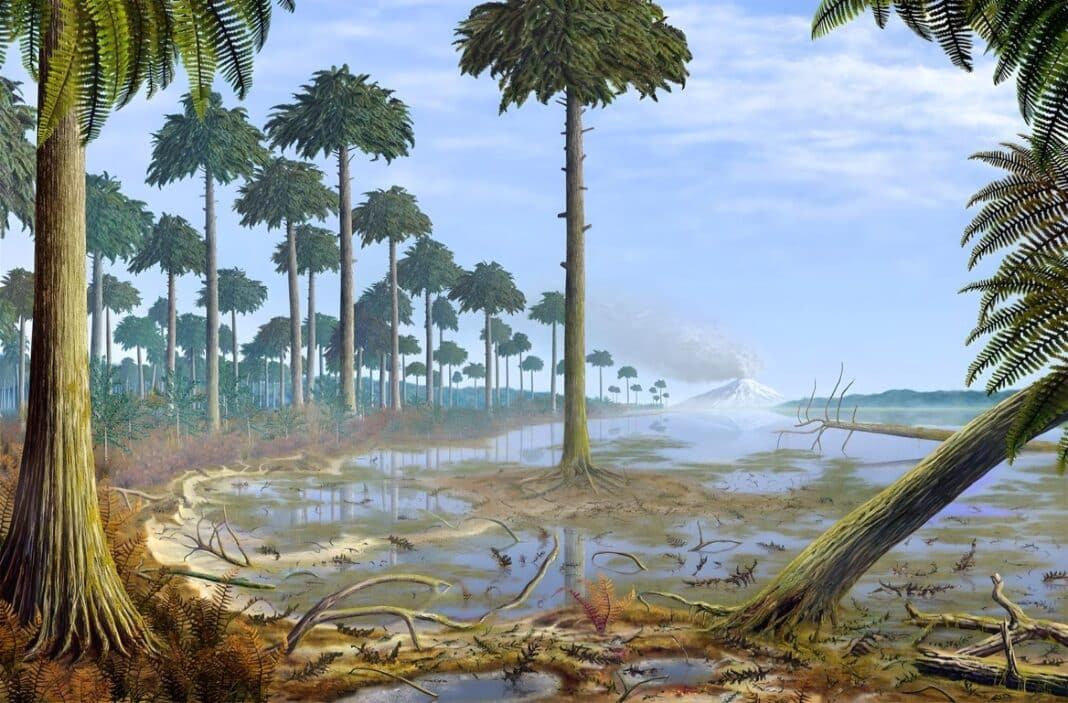The world’s oldest forest is located just 2 hours north of New York City after global archeologists discovered an ancient fossilised root system in Cario in Greene County, New York.
The breakthrough finding, published in the journal Current Biology, dates the existence of forest canopies and tree species back 386 million years.
Drilling into the fossil soil between the trees to investigate geochemical changes, researchers established that the forests – destroyed by a massive flood – provide crucial insights into the role of prehistoric trees in the world’s carbon cycle, as well as its impact on the development of the late Devonian ice ages more than 330 million years ago.
Stretching from New York to Pennsylvania, forests were said to feature trees as tall as 20 metres with trunks up to 1.5 meters in diameter and predate the earliest known forests by at least 2 million years and potentially up to 3 million years.
“These fossil forests are extremely rare,” says Chris Berry, co-author of the Cardiff University’s School of Earth and Ocean Sciences research. “To understand how trees began to draw down carbon dioxide from the atmosphere, we need to understand the ecology and habitats of the earliest forests.”
According to Mr Berry, the forest would have been quite open, and its ancient trees would have appeared alien to the modern eye. An observer in the forest would have encountered clusters of Cladoxylopsid, a 10m-tall leafless tree with a swollen base, short branches resembling celery sticks, and shallow, ribbon-like roots.
Before the latest discovery, the oldest known forest was found in Gilboa, New York, about 40km from the site. That archeological site, found in the 19th century, was home to Gilboa Trees, or Eospermatopteris, one of Earth’s earliest plant species.
Such was the prehistoric era; no birds or vertebrates lived on land when the ancient forest existed. Dinosaurs would not appear on the Earth for another 150 million years, with the forest instead home to millipede-like bugs and other insects.
“It’s funny to think of a forest without large animals,” according to Mr Berry, who spoke to The Guardian. “No birdsong. Just the wind in the trees.”
The archeological site, half the size of a soccer field, contained several “woody roots” of old trees, with three unique root systems — proving that ancient forests had several different tree species.
The fossils also revealed a tree called Archaeopteris, something like a pine, but instead of needles, the branches and trunk were adorned with fern-like fronds, giving it an almost hairy appearance. “It’s not something we can immediately recognise as a modern tree,” said Berry.
The species would have looked like a pine, but instead of needles, the branches and trunk were adorned with fern-like fronds, giving it an almost hairy appearance. “It’s not something we can immediately recognise as a modern tree,” said Berry.
“Archaeopteris seems to reveal the beginning of the future of what forests will ultimately become,” William Stein, a biologist at Binghamton University in New York and lead author of the new study, said in a statement.
“Based on what we know from the body fossil evidence of Archaeopteris before this, and now from the rooting proof that we’ve added at Cairo, these plants are very modern compared to other Devonian plants.”
The prehistoric tree, which bridges the gap between ferns and the earliest known trees, was pivotal in transforming Earth’s ecosystems – with fossils from the “large woody trunks and delicate, fern-like leaves” found in North America, Europe and Asia.
These features make Archaeopteris a precursor to modern trees. Its robust root systems allowed for greater nutrient absorption and stability, fostering more complex forest ecosystems.
First discovered in 2009, researchers have spent the best of 15 years tirelessly analysing the archaeological site to date the trees accurately and identify the species that once lived there.
The emergence of forests is one of the most transformative events in Earth’s history, marking permanent changes to ecology, atmospheric CO2 levels and climate.
Before forests, CO2 levels were far higher, and the Earth’s climate was hotter with no ice caps. By the end of the Devonian period, about 350m years ago, there were glaciers, and soon after, polar ice became permanent.
However, there have been so few fossil remains of early trees that scientists have had only a hazy idea of which trees dominated which habitats, how root systems altered soil chemistry and how forests opened up new ecological niches for animals.
“These remarkable findings have allowed us to move away from the generalities of the importance of large plants growing in forests,” said Berry. “We are getting a handle on the transition of the Earth to a forested planet.”






